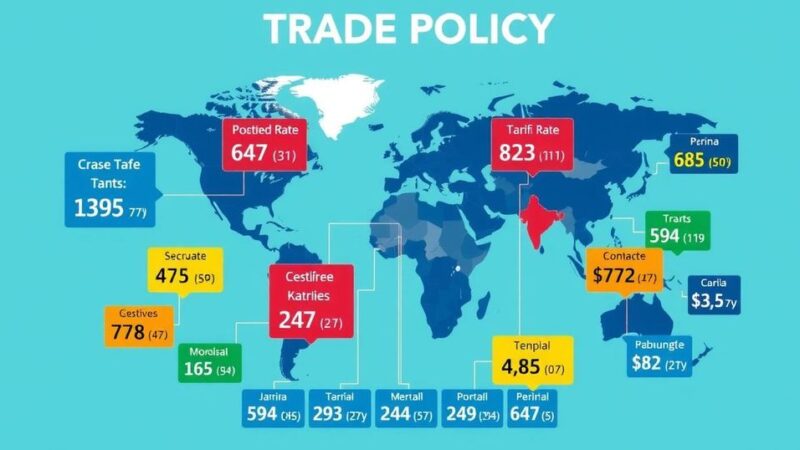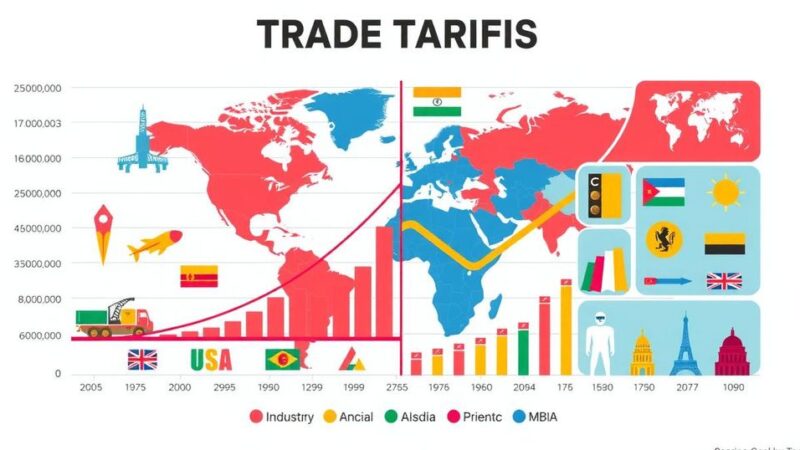President Trump has implemented a 26% discounted reciprocal tariff on imports from India as part of measures against 60 countries with unfair trade barriers. This tariff aims to balance trade and stimulate U.S. manufacturing. However, analysts warn of potential trade wars and economic impacts. U.S.-India negotiations for a bilateral trade agreement are ongoing amidst these developments.
On Thursday, U.S. President Donald Trump formally introduced a 26% “discounted reciprocal tariff” on all imports from India. This action is part of a broader initiative that targets 60 countries identified by his administration as imposing unfair trade barriers against U.S. products. Trump described the tariffs as part of his effort to achieve a more balanced trade framework while enhancing domestic manufacturing.
In his address at the White House, Trump outlined the tariffs as being half of what these nations charge the U.S. However, the basis for arriving at these specific figures remains unclear. He indicated that while the U.S. applies a tariff of 2.4% on motorcycles, India imposes a hefty 70%. He also cited similar high tariffs on automobiles by India, juxtaposing them against the proposed American tariffs.
Trump highlighted the close ties with Prime Minister Narendra Modi, emphasizing that despite their friendship, India has not treated the U.S. equitably in trade negotiations. Meanwhile, the Indian government is anticipated to respond to these tariffs, although any official statement might be delayed due to Modi’s travel to Thailand for an upcoming summit.
During Modi’s previous visit to Washington, both leaders had expressed ambitions to increase bilateral trade to $500 billion by 2030 and to formalize a multi-sector bilateral trade agreement by 2025. This agreement aims to enhance trade flows and improve market accessibility while addressing tariff and non-tariff barriers.
Data from the U.S. Trade Representative estimates that the bilateral trade in goods between India and the U.S. reached approximately $129.2 billion in 2024, showing modest growth compared to the previous year. While the U.S. exported $41.8 billion worth of goods to India, Indian exports amounted to $87.4 billion.
The tariffs for major trade partners include 34% for China, 20% for the EU, and various percentages for other nations. Notably, countries such as Myanmar, Jordan, and Laos are also included in the targeted tariffs list. Trump stated that if foreign countries enhance their manufacturing in the U.S., they would not be subject to tariffs and encouraged them to remove existing barriers.
Trump asserted that his tariff policies have attracted significant investments into the U.S., claiming $6 trillion has been realized due to these threats. However, concerns persist that such tariffs may escalate into global trade wars, potentially hampering the world economy.
Jay Timmons, president of the U.S. National Association of Manufacturers, commented on the detrimental impact of these tariffs, indicating that they could obstruct investment, disrupt supply chains, and ultimately jeopardize America’s competitive edge in manufacturing.
To summarize, President Trump’s announcement of a 26% discounted reciprocal tariff on imports from India aims to address perceived trade inequities. While the initiative seeks to balance international trade and promote domestic manufacturing, there are concerns regarding the potential for retaliatory measures and the broader impact on global economic stability. With key discussions underway between the U.S. and India regarding future trade agreements, the full implications of these tariffs remain to be seen.
Original Source: www.hindustantimes.com






